Author: Kevin Li
Translation: Deep Tide TechFlow
Recently, interest in Ethereum has surged again, especially with the emergence of ETH as a reserve asset. Our fundamental analyst explored the valuation framework of ETH and constructed a compelling long-term bull market forecast. As always, we are happy to connect with you and exchange ideas—please remember to do your own research (DYOR).
Let’s dive deep into ETH with our fundamental analyst Kevin Li.
Key Highlights
Ethereum (ETH) is transitioning from a misunderstood asset to a scarce, programmable reserve asset, providing security and momentum for a rapidly compliant on-chain ecosystem.
The adaptive monetary policy of ETH is expected to reduce the inflation rate— even if 100% of ETH is staked, the inflation rate will peak at about 1.52%, declining to approximately 0.89% by the 100th year (2125). This is far below the average annual growth rate of 6.36% for the U.S. M2 money supply (1998-2024) and can even rival the supply growth rate of gold.
Institutional adoption is accelerating, with companies like JPMorgan and BlackRock building on Ethereum, driving sustained demand for ETH to secure and settle on-chain value.
The annual correlation between on-chain asset growth and native ETH staking exceeds 88%, highlighting strong economic consistency.
The U.S. Securities and Exchange Commission (SEC) released a policy statement on staking on May 29, 2025, reducing regulatory uncertainty. The filing documents for Ethereum ETFs now include staking provisions, enhancing returns and bolstering institutional consistency.
The deep composability of ETH makes it a productive asset—usable for staking/re-staking, as DeFi collateral (e.g., Aave, Maker), AMM liquidity (e.g., Uniswap), and as a native gas token on Layer 2.
While Solana gained attention in Memecoin activities, Ethereum's stronger decentralization and security enable it to dominate the issuance of high-value assets—a larger, more enduring market.
The rise of Ethereum reserve asset trading, starting with Sharplink Gaming ($SBET) in May 2025, has led public companies to hold over 730,000 ETH. This new demand trend mirrors the 2020 Bitcoin reserve asset trading wave and has contributed to ETH recently outperforming BTC.
Not long ago, Bitcoin was widely regarded as a compliant store of value—its narrative as "digital gold" seemed fanciful to many. Today, Ethereum (ETH) faces a similar identity crisis. ETH is often misunderstood, has underperformed in annual returns, missed key meme cycles, and experienced a slowdown in retail adoption across much of the crypto ecosystem.
A common criticism is that ETH lacks a clear value accumulation mechanism. Critics argue that the rise of Layer 2 solutions has eroded base layer fees, undermining ETH's status as a monetary asset. When viewed primarily through the lens of transaction fees, protocol revenue, or "real economic value," ETH begins to resemble a cloud computing security—more like Amazon stock than a sovereign digital currency.
In my view, this framework constitutes a category error. Evaluating ETH solely through cash flow or protocol fees confuses fundamentally different asset classes. Instead, it is better understood through a commodity framework similar to Bitcoin. More accurately, ETH constitutes a unique asset class: a scarce yet productive, programmable reserve asset whose value accumulates through its role in securing, settling, and driving an increasingly institutionalized, composable on-chain economy.
Currency Devaluation: Why the World Needs Alternatives
To fully understand ETH's evolving monetary role, it must be placed within a broader economic context, especially in an era of fiat currency devaluation and monetary expansion. Under ongoing government stimulus and spending, inflation rates are often underestimated. Although official CPI data shows inflation hovering around 2% annually, this metric may be adjusted and could obscure the true decline in purchasing power.
From 1998 to 2024, the average annual CPI inflation rate was 2.53%. In contrast, the average annual growth rate of the U.S. M2 money supply was 6.36%, outpacing inflation and housing prices, and approaching the S&P 500 index's 8.18% return rate. This even suggests that nominal growth in the stock market may largely stem from monetary expansion rather than productivity improvements.

Figure 1: Returns of the S&P 500 Index, Consumer Price Index, M2 Supply, and Housing Price Index (HPI)
Source: Federal Reserve Economic Data
The rapid growth of the money supply reflects the government's increasing reliance on monetary stimulus and fiscal spending plans to address economic instability. Recent legislation, such as Trump's "Build Back Better" (BBB) plan, introduced radical new spending measures that are widely believed to lead to inflation. Meanwhile, the launch of the government efficiency department (DOGE), heavily advocated by Elon Musk, seems to have not achieved the expected results. These developments have led to a growing consensus that the existing monetary system is inadequate, creating an urgent need for a more reliable store of value asset or form of currency.
What Constitutes a Store of Value—And ETH's Positioning
A reliable store of value typically meets four criteria:
Durability—It must withstand the test of time without degrading.
Value Preservation—It should maintain purchasing power throughout market cycles.
Liquidity—It must be easily tradable in active markets.
Adoption and Trust—It must be widely trusted or adopted.
Today, ETH excels in durability and liquidity. Its durability stems from Ethereum's decentralized and secure network. Its liquidity is also high: ETH is the second most traded cryptocurrency, with a rich market on both centralized and decentralized exchanges.
However, when evaluated purely from a traditional "store of value" perspective, its value preservation, application, and trustworthiness remain contentious standards. This is why the concept of "scarce programmable reserve asset" is more fitting, highlighting ETH's positive role in value maintenance and trust-building, along with its unique mechanisms.
ETH's Monetary Policy: Scarce Yet Adaptive
One of the most contentious aspects of ETH's role as a store of value is its monetary policy, particularly its control over supply and inflation. Critics often point out Ethereum's lack of a fixed supply cap. However, this criticism overlooks the architectural complexity of Ethereum's adaptive issuance model.
The issuance of ETH is dynamically related to the amount of ETH staked. While issuance increases with higher staking participation, this relationship is sub-linear: the growth rate of inflation is lower than the growth rate of total staked ETH. This is because issuance is inversely proportional to the square root of the total staked ETH, naturally moderating inflation.

Figure 2: Rough formula for inflation of staked ETH
This mechanism introduces a soft cap on inflation, meaning that even as staking participation increases, the inflation rate will gradually decline over time. In the worst-case simulated scenario (i.e., 100% of ETH is staked), the annual inflation rate cap is approximately 1.52%.
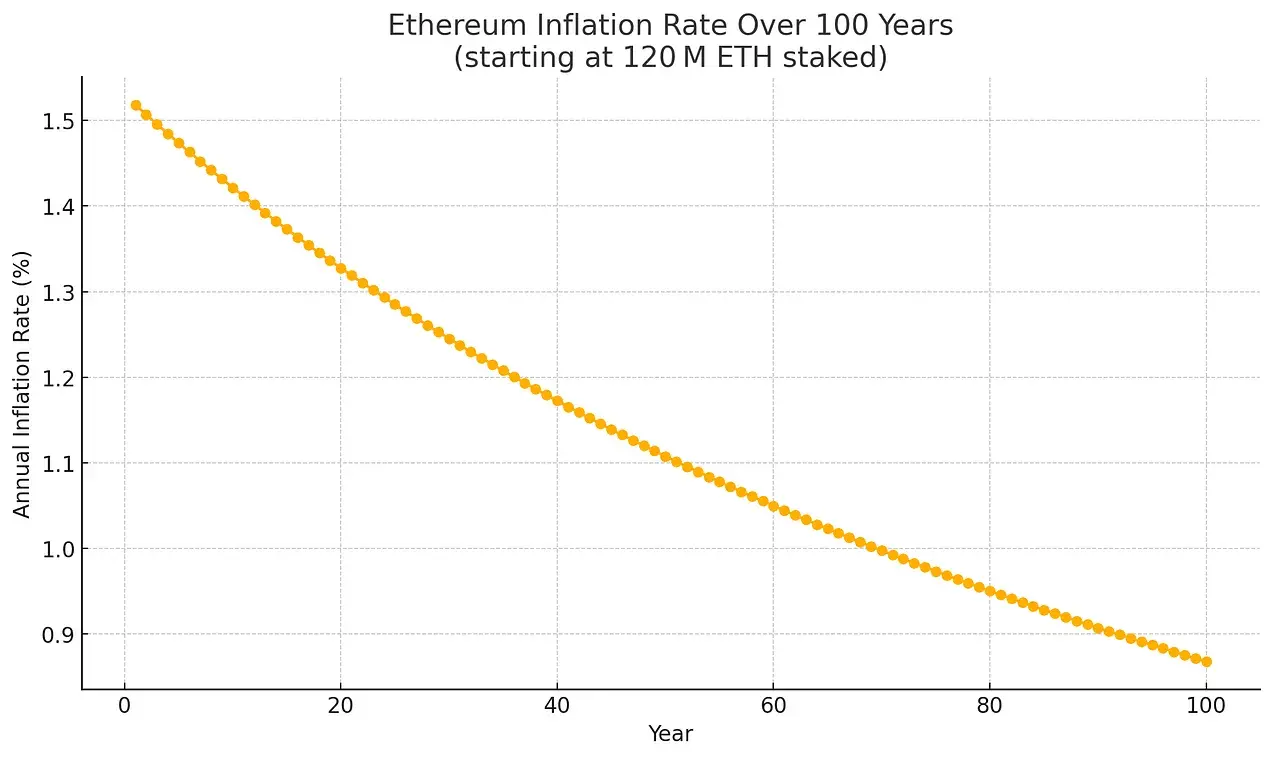
Figure 3: Illustrative inference of ETH's maximum issuance, assuming 100% of ETH is staked, with an initial staking amount of 120 million ETH over a period of 100 years
Importantly, even this worst-case issuance rate will decline as the total supply of ETH increases, following an exponential decay curve. Assuming 100% staking with no ETH burned, the expected inflation trend is as follows:
Year 1 (2025): ~1.52%
Year 20 (2045): ~1.33%
Year 50 (2075): ~1.13%
Year 100 (2125): ~0.89%
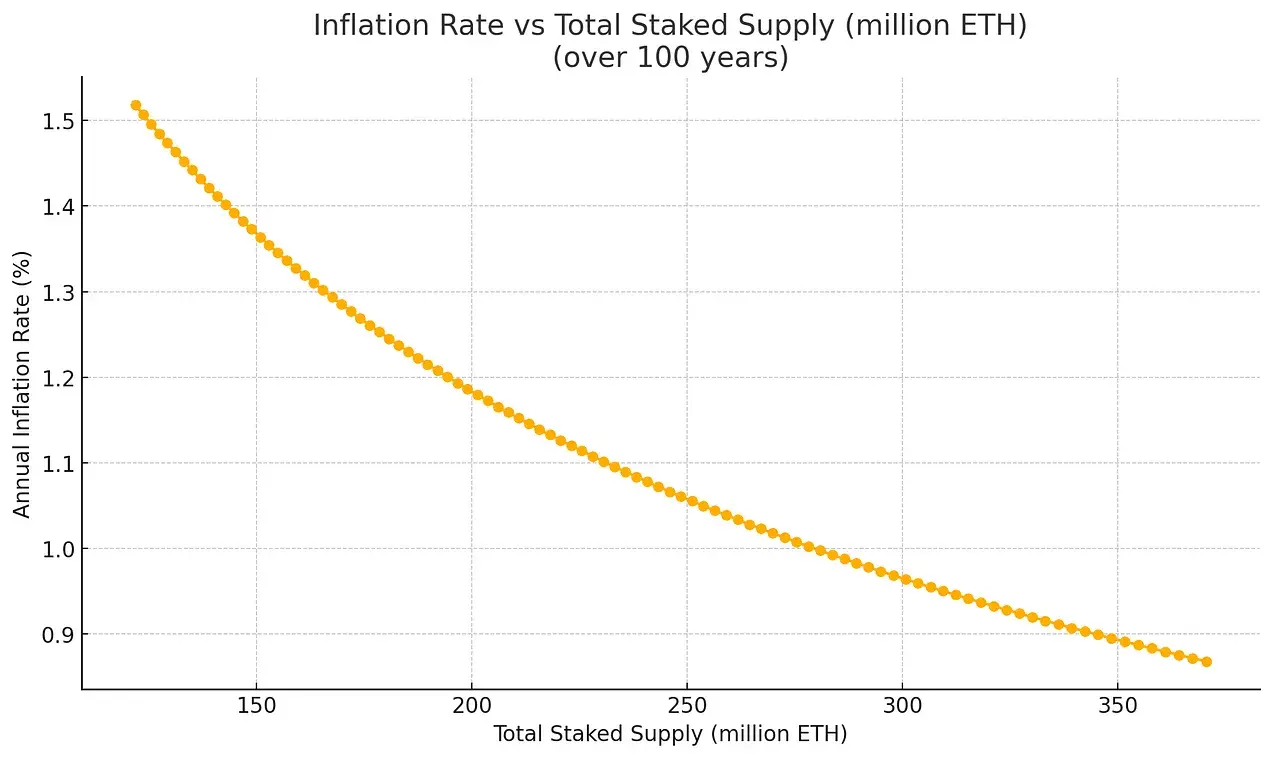
Figure 4: Illustrative inference of ETH's maximum issuance, assuming 100% of ETH is staked, with an initial staking amount of 120 million ETH, as total supply increases
Even under these conservative assumptions, Ethereum's continuously declining inflation curve reflects its inherent monetary principles—enhancing its credibility as a long-term store of value. If we consider the destruction mechanism introduced by Ethereum through EIP-1559, the situation improves further. A portion of transaction fees will permanently exit circulation, meaning the net inflation rate could be far below the total issuance, and at times even fall into deflation. In fact, since Ethereum transitioned from proof-of-work to proof-of-stake, the net inflation rate has remained below the issuance rate and has periodically dipped into negative territory.

Figure 5: Annualized ETH supply inflation rate
Compared to fiat currencies like the dollar (whose M2 money supply has an average growth rate exceeding 6%), Ethereum's structural constraints (and potential deflation) enhance its appeal as a store of value asset. Notably, Ethereum's maximum supply growth rate currently rivals that of gold, and is even slightly lower than gold, further solidifying its position as a robust monetary asset.
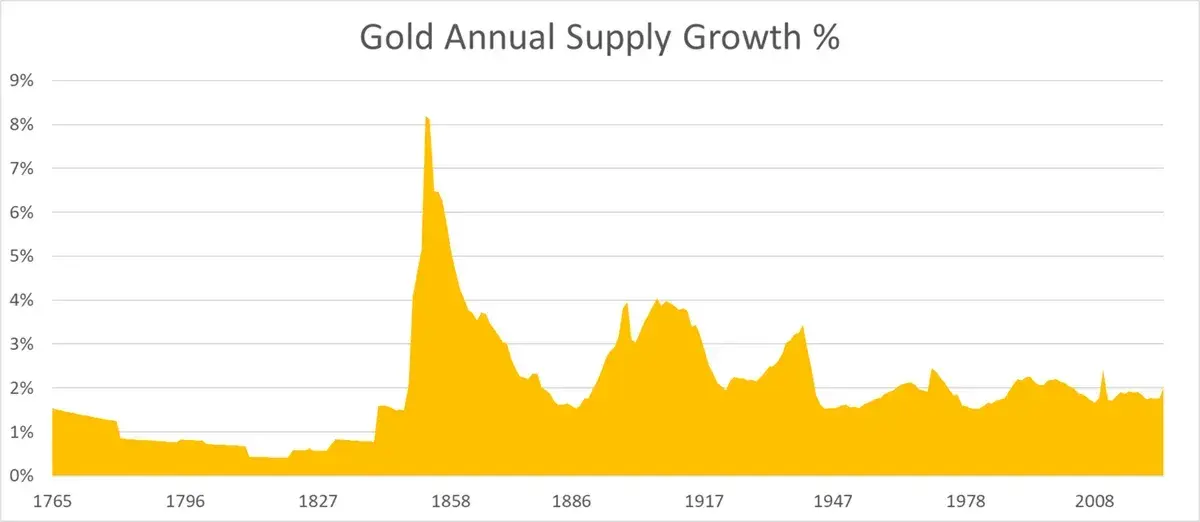
Figure 6: Annual supply growth rate of gold
Source: ByteTree, World Gold Council, Bloomberg, Our World in Data
Institutional Adoption and Trust
Although Ethereum's monetary design effectively addresses supply dynamics, its actual utility as a settlement layer has now become the main driver of adoption and institutional trust. Major financial institutions are building directly on Ethereum: Robinhood is developing a tokenized stock platform, and JPMorgan is launching its deposit token (JPMD) on Ethereum Layer 2 (Base), and BlackRock is using BUIDL to tokenize a money market fund on the Ethereum network.
This on-chain process is driven by a strong value proposition that addresses legacy inefficiencies and unlocks new opportunities:
Efficiency and Cost Reduction: Traditional finance relies on intermediaries, manual steps, and slow settlement processes. Blockchain simplifies these processes through automation and smart contracts, reducing costs, minimizing errors, and shortening processing times from days to seconds.
Liquidity and Fractional Ownership: Tokenization enables fractional ownership of illiquid assets like real estate or art, broadening investor access and unlocking trapped capital.
Transparency and Compliance: The immutable ledger of blockchain ensures verifiable audit trails, simplifying compliance and reducing fraud through real-time visibility into transactions and asset ownership.
Innovation and Market Access: Composable on-chain assets allow for new products (such as automated lending or synthetic assets) to create new revenue streams and expand financial reach beyond traditional systems.
ETH Staking as Security and Economic Coordination
The on-chain migration of traditional financial assets highlights two main drivers of ETH demand. First, the continuous growth of real-world assets (RWA) and stablecoins increases on-chain activity, driving up demand for ETH as a gas token. More importantly, as Tom Lee observed, institutions may need to purchase and stake ETH to secure the infrastructure they rely on, aligning their interests with Ethereum's long-term security. In this context, stablecoins represent Ethereum's "ChatGPT moment," a significant breakthrough use case that showcases the platform's transformative potential and broad utility.
As more value settles on-chain, the consistency between Ethereum's security and its economic value becomes increasingly important. Ethereum's finality mechanism, Casper FFG, ensures that a block can only be finalized when the vast majority (two-thirds or more) of staked ETH reaches consensus. While an attacker controlling at least one-third of staked ETH cannot finalize malicious blocks, they can severely undermine finality by disrupting consensus. In this scenario, Ethereum can still propose and process blocks, but due to the lack of finality, these transactions may be reversed or reordered, posing significant settlement risks for institutional use cases.
Even when operating on Layer 2 that relies on Ethereum for final settlement, institutional participants depend on the security of the base layer. Layer 2 does not undermine ETH; rather, it enhances the value of ETH by driving demand for base layer security and gas. They submit proofs to Ethereum, pay base fees, and typically use ETH as their native gas token. As the scale of Rollup execution expands, Ethereum continues to accumulate value through its foundational role in providing secure settlement.
In the long run, many institutions may move beyond passive staking through custodians and begin operating their own validators. While third-party staking solutions offer convenience, operating validators allows institutions greater control, enhanced security, and direct participation in consensus. This is particularly valuable for stablecoin and RWA issuers, as it enables them to capture MEV, ensure reliable transaction inclusion, and leverage privacy execution—features critical for maintaining operational reliability and transaction integrity.
Importantly, broader institutional participation in validating node operations helps address one of Ethereum's current challenges: the concentration of staking in a few large operators, such as liquidity staking protocols and centralized exchanges. By diversifying the validator node set, institutional participation helps enhance Ethereum's decentralization, bolster its resilience, and strengthen the network's credibility as a global settlement layer.
A significant trend from 2020 to 2025 reinforces the consistency of this incentive mechanism: the growth of on-chain assets is closely correlated with the growth of staked ETH. As of June 2025, the total supply of stablecoins on Ethereum reached a record $116.06 billion, while tokenized RWAs climbed to $6.89 billion. Meanwhile, the amount of staked ETH grew to 35.53 million ETH, highlighting how network participants balance security and on-chain value.
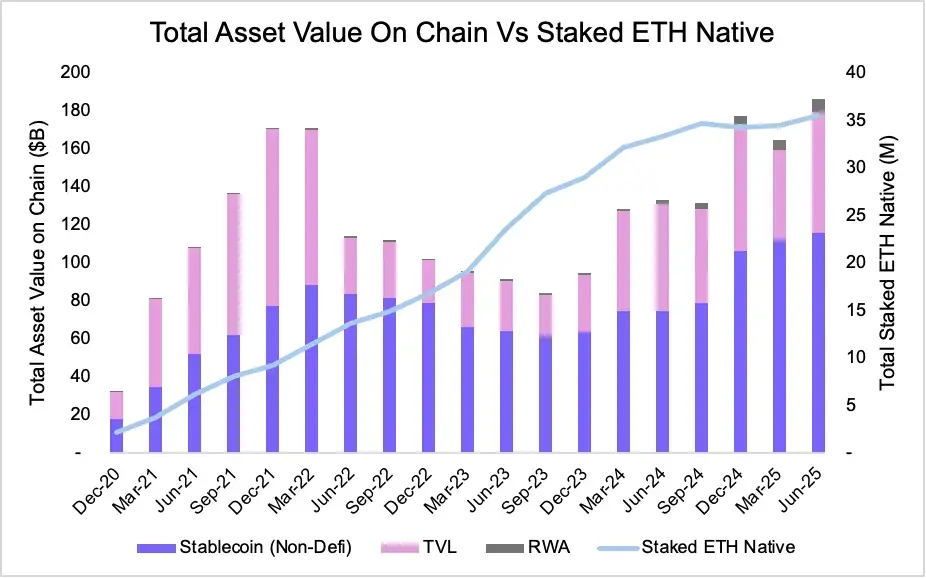
Figure 7: Total On-Chain Value of ETH vs. Value of Staked Native ETH
Source: Artemis
From a quantitative perspective, the annual correlation between the growth of on-chain assets and the amount of native ETH staked has remained above 88% among major asset classes. Notably, the supply of stablecoins is closely related to the growth of staked ETH. While quarterly correlations may exhibit significant volatility due to short-term fluctuations, the overall trend remains unchanged— as assets flow on-chain, the motivation to stake ETH also increases.
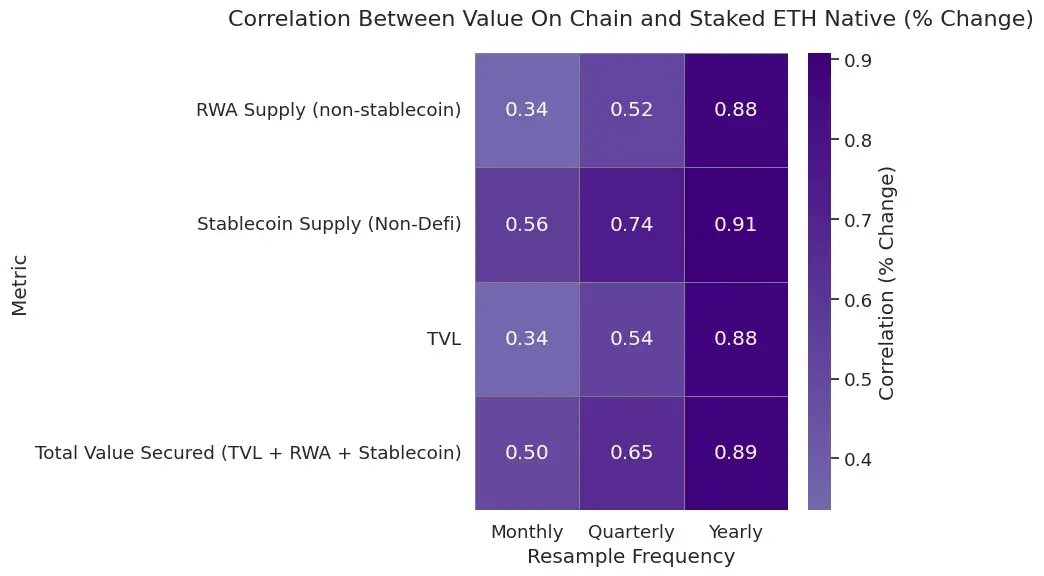
Figure 8: Monthly, Quarterly, and Annual Native Correlation of Staked ETH with On-Chain Value
Source: Artemis
Additionally, the increase in staking volume also affects ETH's price dynamics. As more ETH is staked and removed from circulation, the supply of ETH tightens, especially during periods of high on-chain demand. Our analysis shows that the annual correlation between the amount of staked ETH and the price of ETH is 90.9%, while the quarterly correlation is 49.6%, supporting the view that staking not only secures the network but also exerts favorable supply-demand pressure on ETH itself in the long run.
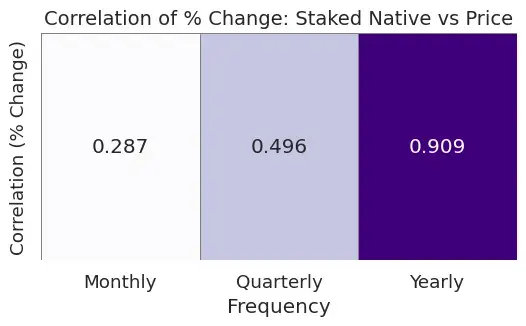
Figure 9: Native Correlation of Staked ETH with Price
Source: Artemis
The U.S. Securities and Exchange Commission (SEC) recently issued a policy clarification that alleviated regulatory uncertainty surrounding Ethereum staking. On May 29, 2025, the SEC's Division of Corporation Finance stated that certain staking activities (limited to non-entrepreneurial roles, such as self-staking, delegated staking, or custodial staking under specific conditions) do not constitute securities offerings. While more complex arrangements still need to be determined based on the facts and circumstances, this clarification encourages institutions to participate more actively. Following the announcement, Ethereum ETF application documents began to include staking provisions, allowing funds to earn rewards while maintaining network security. This not only enhances return rates but also further solidifies institutional acceptance and trust in Ethereum's long-term adoption.
Composability and ETH as a Productive Asset
Another significant feature that distinguishes ETH from pure store-of-value assets like gold and Bitcoin is its composability, which itself drives demand for ETH. Gold and BTC are non-productive assets, while ETH possesses native programmability. It plays an active role in the Ethereum ecosystem, supporting decentralized finance (DeFi), stablecoins, and Layer 2 networks.
Composability refers to the ability of protocols and assets to interoperate seamlessly. In Ethereum, this means that ETH is not only a monetary asset but also a foundational building block for on-chain applications. As more protocols are built around ETH, the demand for ETH grows—not only as gas but also as collateral, liquidity, and staking capital.
Today, ETH is used for various key functions:
Staking and Re-staking—ETH can secure Ethereum itself and can be re-staked through EigenLayer to provide security for oracles, rollups, and middleware.
Collateral in Lending and Stablecoins—ETH supports major lending protocols like Aave and Maker and serves as the basis for over-collateralized stablecoins.
Liquidity in AMMs—ETH dominates decentralized exchanges like Uniswap and Curve, enabling efficient swaps across the entire ecosystem.
Cross-chain Gas—ETH is the native gas token for most Layer 2s, including Optimism, Arbitrum, Base, zkSync, and Scroll.
Interoperability—ETH can be bridged, wrapped, and used across non-EVM chains like Solana and Cosmos (via Axelar), making it one of the most widely transferable assets on-chain.
This deeply integrated utility makes ETH a scarce yet efficient reserve asset. As ETH becomes increasingly embedded in the ecosystem, switching costs rise, and network effects strengthen. In a sense, ETH may resemble gold more than BTC. Much of gold's value comes from its industrial and jewelry applications, not just investment. In contrast, BTC lacks this functional utility.
Ethereum vs. Solana: Layer-1 Divergence
In this cycle, Solana appears to be the biggest winner in the Layer 1 space. It has effectively captured the memecoin ecosystem, creating a vibrant network for the issuance and development of new tokens. While this momentum does exist, Solana's degree of decentralization remains inferior to Ethereum due to its limited number of validators and high hardware requirements.
That said, the demand for Layer 1 block space may present a stratified landscape. In this stratified future, both Solana and Ethereum can thrive. Different assets will need to make varying trade-offs between speed, efficiency, and security. However, in the long run, Ethereum—due to its stronger decentralization and security guarantees—may capture a larger share of asset value, while Solana may dominate higher transaction frequency.
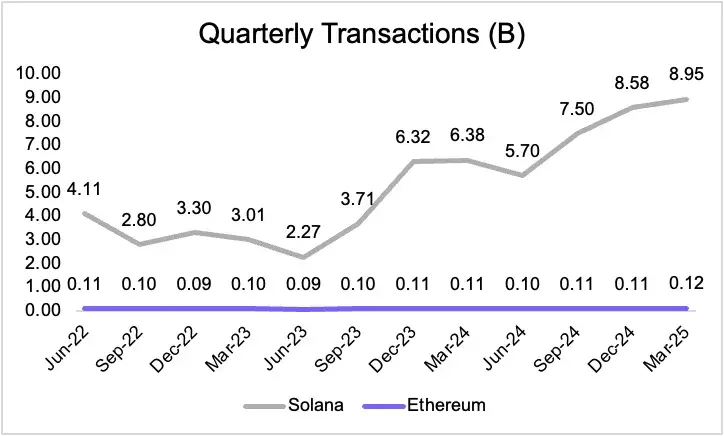
Figure 10: Quarterly Trading Volume of SOL vs. ETH
However, in financial markets, the market size for assets that pursue robust security is far greater than that for assets that focus solely on execution speed. This dynamic is favorable for Ethereum: as more high-value assets go on-chain, Ethereum's role as a foundational settlement layer will become increasingly valuable.
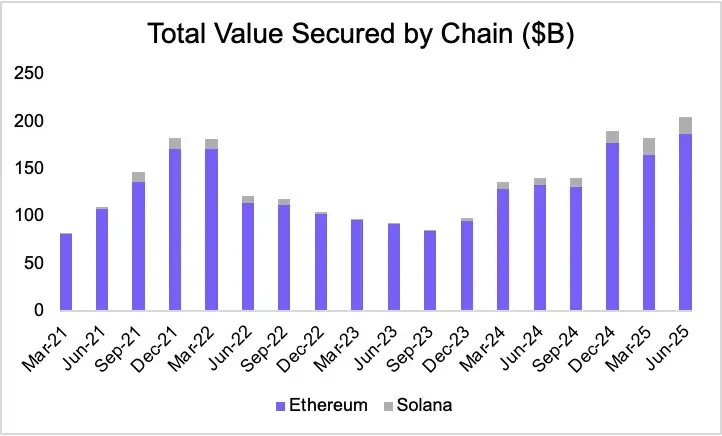
Figure 11: Total Value of On-Chain Collateral (in billions of dollars)
Source: Artemis
Reserve Asset Momentum: ETH's MicroStrategy Moment
While on-chain assets and institutional demand are long-term structural drivers for ETH, Ethereum's asset management strategy—similar to how MicroStrategy (MSTR) utilizes Bitcoin—may serve as a continuous catalyst for ETH's asset value. A key turning point in this trend was Sharplink Gaming's ($SBET) announcement of its Ethereum asset management strategy at the end of May, led by Ethereum co-founder Joseph Lubin.

Figure 12: ETH Reserve Asset Holdings
Source: strategicethreserve.xyz
The asset management strategy serves as a tool for token acquisition of traditional finance (TradFi) liquidity while enhancing the per-share asset value of the related companies. Since the emergence of Ethereum-based asset management strategies, these firms have accumulated over 730,000 ETH, and ETH's performance has begun to surpass that of Bitcoin—something rare in this cycle. We believe this marks the beginning of a broader trend toward Ethereum-centric asset management applications.
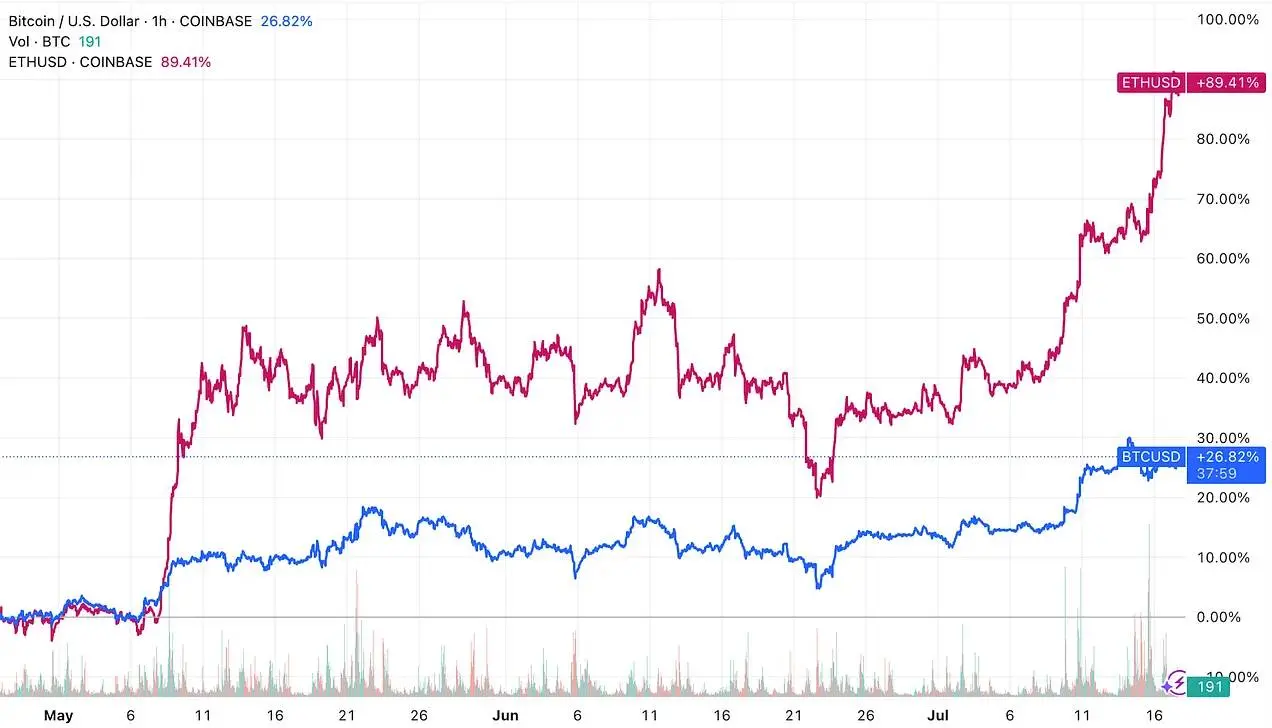
Figure 13: Price Trends of ETH and BTC
Conclusion: ETH as the Reserve Asset of the On-Chain Economy
The evolution of Ethereum reflects a broader paradigm shift in the concept of monetary assets within the digital economy. Just as Bitcoin overcame early skepticism to earn recognition as "digital gold," Ether (ETH) is establishing its unique identity—not by mimicking Bitcoin's narrative, but by evolving into a more versatile and foundational asset. ETH is not merely akin to cloud computing securities, nor is it limited to being a utility token for transaction fees or a source of protocol revenue. Instead, it represents a scarce, programmable, and economically essential reserve asset—supporting the security, settlement, and functionality of an increasingly institutionalized on-chain financial ecosystem.
免责声明:本文章仅代表作者个人观点,不代表本平台的立场和观点。本文章仅供信息分享,不构成对任何人的任何投资建议。用户与作者之间的任何争议,与本平台无关。如网页中刊载的文章或图片涉及侵权,请提供相关的权利证明和身份证明发送邮件到support@aicoin.com,本平台相关工作人员将会进行核查。




